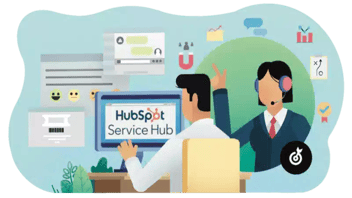Managing Your Sales to Customer Success Handoff
A smooth transition between sales and customer success teams is crucial for a positive customer experience, and businesses recognize the importance of a seamless customer success handoff.
However, transitioning from pre-sale to post-sale and implementation can often be a significant friction point. Explore strategies to minimize this friction, ensuring customers a seamless and positive experience throughout their journey.

Before discussing how to solve this problem, let's dive further into the problem. When a customer's primary point of contact moves from one person to another, they enter the danger zone. The danger zone is when a customer advocate starts to forget essential customer details, such as the terms of an agreement or their idea of mutual success. Entering the danger zone is troublesome for a variety of reasons. When vital information gets lost between team members, this creates tension and costs time. If a knowledge transfer fails, customers must repeat themselves, and essential expectations can be lost or miscommunicated.
These dilemmas increase a customer's time-to-value ratio: the amount of time taken to see value in the product or service purchased. Each time a customer is forced to reset their expectations, the longer it takes for them to find success in this process. The relationship between time and value is inverse, meaning that more time taken will result in less perceived customer success and vice versa. As an organization, you should strive to keep customers' time-to-value ratio as low as possible, respecting both your time and theirs. Handoffs between representatives can make or break this ratio, which is why they must be smooth and seamless.
So, why is it so important to demonstrate success to customers who have already made a purchase? Customers who see less success in the sales process will be less likely to repeat their purchases in the future. It is crucial to care for your customers throughout the entire sales process to transform them into repeat purchasers. Not only does this turn your customers into promoters, encouraging others to buy from you, but it also saves your business time and money. It is twenty-five times more costlier to acquire a new customer than to keep an existing one, so customer retention is vital.
Now that you understand the importance of successful customer handoff, we will discuss how to avoid friction within them. Most conflict points occur when a customer transitions from one primary point of contact to another, most often between the sales team and the customer success team. While most friction occurs here, it is not necessarily at the fault of either point of contact. A customer may forget what was said or change their mind during stages of success. Still, it is the responsibility of the company's representatives to ensure smooth transitions and satisfied customers.
The most efficient way to achieve a smooth and successful handoff is to create a Sales to Customer Success Handoff Playbook. This five-step playbook provides businesses with the means to open communication between teams and find a method that works best for their organization and customers.
1. Goals
- Articulate clear goals for both the sales and customer success teams.
- Align the goals of the two teams.
- Use the same measurement of success to allow for comparison (e.g., customer retention rate).
2. Buddy System
- Pair sales members with customer success members.
- Create a meaningful cross-functional relationship.
- Improves and opens communication.
- Builds empathy.
- Provides each team member with a point of contact on the other team.
- Provide sample questions to open discussion:
- What is the hardest part of your job?
- How can my team better help your team?
- What are the most significant problems your team is trying to solve?
- Organize regular meetings between buddies (virtual or in-person).
3. Note Templates
- Pre-designed outlines that team members can fill out to accurately pass information to another team.
- Include: The main point of contact, the reason for purchase, the timeline, things to be aware of, and goals.
- Fosters an expectation for clear communication.
- The template should be as easy-to-use as possible to incentivize sales employees to use it and take up minimal time.
- Descriptive notes eliminate unnecessary repetition.
- Have customer success employees take notes at the end of the process to compare with the sales team and use them for future purchases.
4. Feedback
- Situation, Behavior, Impact (SBI) model
- A model for delivering useful and objective feedback by focusing on specific situations and outlining the impact these behaviors have on others.
- Situation: clearly outline the situation.
- Behavior: discuss the specific behavior to be addressed.
- Impact: highlight the impact of their behavior on you, the team, and the organization.
- For both positive and negative feedback, reach out to the customer and let them know you heard them.
- Provide actionable feedback for colleagues to provide them with an opportunity for improvement.
- Instead of "You need to produce more," suggest, "I need to find a way for us to be more productive today, can I count on you to do that?"
5. Resources
- Create a "who's who" list of team members.
- List of members of both sales and customer success teams and the skills they are an expert in.
- Allow team members to reach out to anyone on the list who is proficient in the skills they require.
- It opens communication between teams while allowing others to develop their skills.
- Encourages employees to seek help from colleagues rather than management.
A customized playbook ensures open communication between your sales and customer service teams. As a result, you will reduce buyer's remorse in your customers and increase customer retention, turning your customers into your promoters. While this playbook may look different for each company, it should provide a template for outlining goals and expectations for your company with the resources to achieve them. While implementing this into your success plan, ensure that all parties involved clearly understand what it takes to create a seamless sales to customer success handoff.
This content is also available in:
- German: Management der Übergabe zwischen Vertrieb und Kundenerfolg
- Spanish: Gestión del traspaso de ventas a éxito del cliente
- French: Gérer le passage des ventes à la réussite des clients
- Italian: Gestire il passaggio dalle vendite al successo del cliente
- Romanian: Gestionarea transferului de la vânzări la succesul clientului
- Chinese: 管理销售与客户成功的交接









Leave a Comment